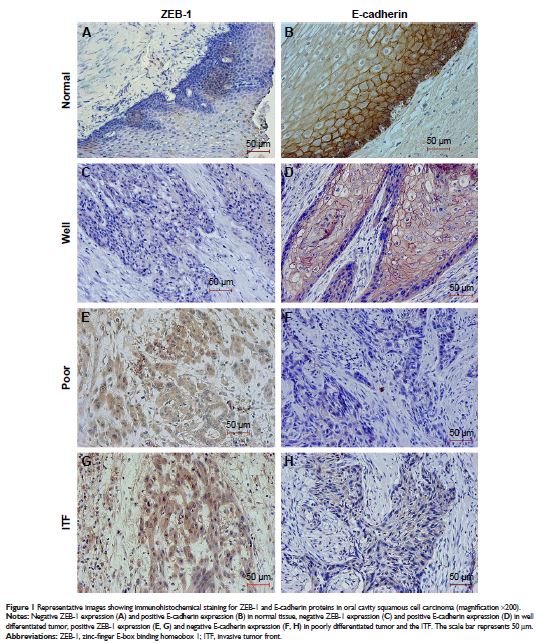9 9 6 5 3
论文已发表
注册即可获取德孚的最新动态
IF 收录期刊
- 3.3 Breast Cancer (Dove Med Press)
- 3.4 Clin Epidemiol
- 2.5 Cancer Manag Res
- 2.9 Infect Drug Resist
- 3.5 Clin Interv Aging
- 4.7 Drug Des Dev Ther
- 2.7 Int J Chronic Obstr
- 6.6 Int J Nanomed
- 2.5 Int J Women's Health
- 2.5 Neuropsych Dis Treat
- 2.7 OncoTargets Ther
- 2.0 Patient Prefer Adher
- 2.3 Ther Clin Risk Manag
- 2.5 J Pain Res
- 2.8 Diabet Metab Synd Ob
- 2.8 Psychol Res Behav Ma
- 3.0 Nat Sci Sleep
- 1.8 Pharmgenomics Pers Med
- 2.7 Risk Manag Healthc Policy
- 4.2 J Inflamm Res
- 2.1 Int J Gen Med
- 4.2 J Hepatocell Carcinoma
- 3.7 J Asthma Allergy
- 1.9 Clin Cosmet Investig Dermatol
- 2.7 J Multidiscip Healthc

ZEB-1 和 E-钙粘蛋白对口腔鳞状细胞癌患者中的临床病理学意义
Authors Yao X, Sun S, Zhou X, Zhang Q, Guo W, Zhang L
Received 3 May 2016
Accepted for publication 31 October 2016
Published 13 February 2017 Volume 2017:10 Pages 781—790
DOI https://doi.org/10.2147/OTT.S111920
Checked for plagiarism Yes
Review by Single-blind
Peer reviewers approved by Dr Amy Norman
Peer reviewer comments 2
Editor who approved publication: Dr William Cho
Background: Zinc-finger E-box binding homeobox 1 (ZEB-1), a member of the ZFH
family, plays a key role in epithelial–mesenchymal transition during tumor
progression in various cancers. However, little information is available on
ZEB-1 expression in oral cavity squamous cell carcinoma (OSCC).
Methods: The expression levels of ZEB-1 and E-cadherin were
assessed by immunohistochemistry in a cohort of 120 patients with OSCC treated
by curative operation, and then the correlations between ZEB-1 and E-cadherin
expression and clinical factors were evaluated, including patient prognosis.
Quantitative real-time polymerase chain reaction (qRT-PCR) assays were
performed to assess mRNA levels of ZEB-1 and E-cadherin in 20 matched OSCC
specimens.
Results: Patients were followed up for a median period of 66
months (range 8-116 months), and 5-year overall survival was 68.3%. Positive
ZEB-1 and E-cadherin immunostaining reactivity was detected in 64 (53.3%) and
53 (44.2%) patients, respectively. There was a negative correlation between ZEB-1
expression and E-cadherin expression. In addition, overexpression of ZEB-1 was
significantly associated with recurrence, lymph node metastasis, and pathologic
grading of patients, loss of E-cadherin was significantly associated with lymph
node metastasis and pathologic grading of patients. Univariate analysis showed
that increased ZEB-1 expression, loss of E-cadherin expression, lymph node
metastasis, recurrence, and pathology grade were prognostic factors. In
multivariate analysis, increased ZEB-1 expression and recurrence remained
independent prognostic factors. In particular, patients with both ZEB-1
positivity and loss of E-cadherin expression had a poorer prognosis. qRT-PCR
showed that ZEB-1 mRNA expression was higher in OSCC compared to the adjacent
nontumorous tissues, while E-cadherin mRNA expression was lower in tumor
tissues.
Conclusion: This study shows that overexpression of ZEB-1 and loss
of E-cadherin expression are significantly correlated with poor survival in
OSCC patients, and ZEB-1 expression might serve as an independent prognostic
biomarker of OSCC.
Keywords: ZEB-1,
E-cadherin, EMT, oral squamous cell carcinoma, prognosis
